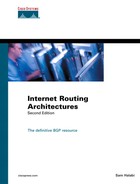Controlling BGP Routes
The preceding section discussed the existence of policy engines, which provide attribute manipulation and route filtering. This section discusses in detail attribute manipulation and route filtering, which are the keys to controlling routing information. Each BGP attribute is examined to illustrate what is manipulated.
Traffic inside and outside an AS always flows according to the road map laid out by routes. Altering the routes translates into changes in traffic behavior. Here are some of the more common questions that organizations and service providers ask about controlling routes:
-
How do I prevent my private networks from being advertised?
-
How do I filter routing updates coming from a particular neighbor?
-
How do I make sure that I use this link or this provider rather than another one?
As you will see, BGP provides the necessary hooks and attributes to address all these questions and more.
BGP Path Attributes
The BGP attributes are a set of parameters that describe the characteristics of a prefix (route). The BGP decision process couples these attributes with the prefix they describe, compares all the paths available to reach a given destination, and then selects the best routes to be used to reach the destination. Remember that attributes are part of each BGP UPDATE packet and describe the path information of the associated prefix. The next few sections cover these attributes and how they can be manipulated to affect the routing behavior.
Before I describe the BGP path attributes, let's take a brief look at the four separate categories of path attributes:
-
Well-known mandatory
-
Well-known discretionary
-
Optional transitive
-
Optional nontransitive
The following section was extracted from RFC 1771:
Well-known attributes must be recognized by all BGP implementations. Some of these attributes are mandatory and must be included in every UPDATE message. Others are discretionary and may or may not be sent in a particular UPDATE message.
All well-known attributes must be passed along (after proper updating, if necessary) to other BGP peers.
In addition to well-known attributes, each path may contain one or more optional attributes. It is not required or expected that all BGP implementations support all optional attributes. The handling of an unrecognized optional attribute is determined by the setting of the Transitive bit in the attribute flags octet. Paths with unrecognized transitive optional attributes should be accepted. If a path with unrecognized transitive optional attribute is accepted and passed along to other BGP peers, then the unrecognized transitive optional attribute of that path must be passed along with the path to other BGP peers with the Partial bit in the Attribute Flags octet set to 1. If a path with recognized transitive optional attribute is accepted and passed along to other BGP peers and the Partial bit in the Attribute Flags octet is set to 1 by some previous AS, it is not set back to 0 by the current AS. Unrecognized non-transitive optional attributes must be quietly ignored and not passed along to other BGP peers.
New transitive optional attributes may be attached to the path by the originator or by any other AS in the path. If they are not attached by the originator, the Partial bit in the Attribute Flags octet is set to 1. The rules for attaching new non-transitive optional attributes will depend on the nature of the specific attribute. The documentation of each new non-transitive optional attribute will be expected to include such rules. (The description of the MULTI_EXIT_DISC attribute gives an example.) All optional attributes (both transitive and non-transitive) may be updated (if appropriate) by ASs in the path.
The currently defined BGP attributes are described in the following list. More-detailed information is provided in the associated sections thereafter.
-
ORIGIN (Type Code 1)— A well-known mandatory attribute that defines the origin of the path information. The data octet can assume the following values:
-
AS_PATH (Type Code 2)— A well-known mandatory attribute that is composed of a sequence of AS path segments. Each AS path segment is represented by a triple <path segment type, path segment length, path segment value>.
-
NEXT_HOP (Type Code 3)— A well-known mandatory attribute that defines the IP address of the border router that should be used as the next hop to the destinations listed in the Network Layer Reachability field of the UPDATE message.
-
MULTI_EXIT_DISC (Type Code 4)— An optional nontransitive attribute that is a four-octet nonnegative integer. The value of this attribute may be used by a BGP speaker's decision process to discriminate among multiple exit points to a neighboring autonomous system.
-
LOCAL_PREF (Type Code 5)— A well-known discretionary attribute that is a four-octet nonnegative integer. It is used by a BGP speaker to inform other BGP speakers in its own autonomous system of the originating speaker's degree of preference for an advertised route.
-
ATOMIC_AGGREGATE (Type Code 6)— A well-known discretionary attribute of length 0. It is used by a BGP speaker to inform other BGP speakers that the local system selected a less-specific route without selecting a more-specific route that is included in it.
-
AGGREGATOR (Type Code 7)— An optional transitive attribute of length 6. The attribute contains the last AS number that formed the aggregate route (encoded as two octets), followed by the IP address of the BGP speaker that formed the aggregate route (encoded as four octets).
-
COMMUNITY (Type Code 8)— An optional transitive attribute of variable length. The attribute consists of a set of four octet values, each of which specifies a community. All routes with this attribute belong to the communities listed in the attribute.
Tip
See the section BGP Attributes in Chapter 11.
The ORIGIN Attribute
The ORIGIN attribute is a well-known mandatory attribute (Type Code 1) that indicates the origin of the routing update with respect to the autonomous system that originated it. BGP considers three types of origins:
-
IGP— The Network Layer Reachability Information (NLRI) is internal to the originating AS.
-
EGP— The Network Layer Reachability Information is learned via the Exterior Gateway Protocol (EGP).
-
INCOMPLETE— The Network Layer Reachability Information is learned by some other means.
BGP considers the ORIGIN attribute in its decision-making process to establish a preference ranking among multiple routes. Specifically, BGP prefers the path with the lowest origin type, where IGP is lower than EGP and EGP is lower than INCOMPLETE. For more details on how the ORIGIN attribute is calculated, see the earlier section "ORIGIN of Routes."
The AS_PATH Attribute
The AS_PATH attribute is a well-known mandatory attribute (Type Code 2) that contains a sequence of autonomous system numbers that represent the path a route has traversed. Internally to an AS, routes passed among BGP speakers leave the AS_PATH information intact; however, when sending routes to external BGP peers, the AS that originates the route adds its own AS number. Thereafter, each AS that receives the route and passes it on to other EBGP peers will prepend its AS number to the list. Prepending is the act of adding the AS number to the beginning of the list. The final list represents all the AS numbers that a route has traversed. The AS number of the AS that originated the route is at the end of the list (just before the ORIGIN code). This type of AS_PATH list is referred to as an AS_SEQUENCE, because all the AS numbers are ordered sequentially.
Tip
See the section The AS_PATH Attribute in Chapter 11.
BGP uses the AS_PATH attribute as part of the routing updates (UPDATE packet) to ensure a loop-free topology on the Internet. Each route that is passed between BGP peers carries a list of all AS numbers that the route has traversed. If the route is advertised to an AS whose AS number is already present in the AS_SEQUENCE, the UPDATE is ignored. BGP speakers prepend their AS numbers when advertising routing updates to other ASs. When the route is passed to a BGP speaker within the same AS, the AS_PATH information is left intact.
Figure 6-11 illustrates the AS_PATH attribute at each instance of the route 172.16.10.0/24, originating in AS1 and passed to AS2, then AS3 and AS4, and back to AS1. Note how each AS that passes the route to other external peers adds its own AS number to the beginning of the list. When the route gets back to AS1, the AS1 BGP border router realizes that this route has already been through its AS (AS number 1 appears in the list) and will not accept the route.
Figure 6-11. Sample Loop Condition Addressed by the AS_PATH Attribute

AS_PATH information is one of the attributes BGP uses to determine the best route to take to reach a destination. In comparing two or more different routes, given that all higher-priority attributes are equal, a shorter AS_PATH is always preferred over a longer one. In case of a tie, other attributes are used to determine the best path to the destination. (See the earlier section "BGP Decision Process Summary.")
The NEXT_HOP Attribute
The NEXT_HOP attribute is a well-known mandatory attribute (Type Code 3). This varies slightly when used in the context of an IGP, where the next hop to reach a destination is the IP address of the connected interface of the router that has announced the route.
Tip
See the section The NEXT_HOP Attribute in Chapter 11.
The next-hop concept with BGP is slightly more elaborate. It takes one of the following four forms:
-
For EBGP sessions, the next hop is the IP address of the neighbor that announced the route.
-
For IBGP sessions, for routes originated inside the AS, the next hop is the IP address of the neighbor that announced the route.
-
For routes injected into the AS via EBGP, the next hop learned from EBGP is carried unaltered into IBGP. The next hop is the IP address of the EBGP neighbor from which the route was learned.
-
When the route is advertised on a multiaccess medium (such as Ethernet, Frame Relay, and so on), the next hop is usually the IP address of the interface of the router connected to the medium that originated the route.
Figure 6-12 illustrates the BGP NEXT_HOP attribute environment.
Figure 6-12. BGP NEXT_HOP Example

The SF router is running an EBGP session with the LA router and an IBGP session with the SJ router. The SF router is learning route 128.213.1.0/24 from the LA router. In turn, the SF router is injecting the local route 192.212.1.0/24 into BGP.
The SJ router learns route 192.212.1.0/24 via 2.2.2.2, the IP address of the IBGP peer announcing the route. Thus, 2.2.2.2 is the next hop, according to the definition, for SJ to reach 192.212.1.0/24. Similarly, the SF router sees 128.213.1.0/24 coming from the LA router via next hop 1.1.1.1. When it passes this route update to the SJ router via IBGP, SF includes the next-hop information, unaltered. Thus, the SJ router would receive the BGP update about 128.213.1.0/24 with next hop 1.1.1.1. This is an example of the EBGP next hop being carried into IBGP.
As you can see from this example, the next hop is not necessarily reachable via a direct connection. For example, SJ's next hop for 128.213.1.0/24 is 1.1.1.1, but reaching it requires a pathway through 3.3.3.3. Thus, the next-hop behavior mandates a recursive IP lookup for a router to know where to send the packet. To reach the next hop 1.1.1.1, the SJ router will recursively look into its IGP routing table to see if and how 1.1.1.1 can be reached. This recursive search continues until the router associates destination 1.1.1.1 with an outgoing interface. The same recursive behavior is performed to reach next hop 2.2.2.2. If a hop can't be reached, BGP considers the route inaccessible.
The following is an example of how IP recursive lookup is used to direct the traffic toward the final destination. Tables 6-2 and 6-3 list the BGP and IP routing tables for the SJ router illustrated in Figure 6-12.
| Destination | Next Hop |
|---|---|
| 192.212.1.0/24 | 2.2.2.2 |
| 128.213.1.0/24 | 1.1.1.1 |
| Destination | Next Hop |
|---|---|
| 192.212.1.0/24 | 2.2.2.2 |
| 2.2.2.0/24 | 3.3.3.3 |
| 3.3.3.0/24 | Connected; Serial 0 |
| 128.213.1.0/24 | 1.1.1.1 |
| 1.1.1.0/24 | 3.3.3.3 |
Table 6-2 indicates that 128.213.1.0/24 can be reached via next hop 1.1.1.1. Looking into the IP routing table, network 1.1.1.0/24 can be reached via next hop 3.3.3.3. Another recursive lookup in the IP routing table indicates that network 3.3.3.0/24 is directly connected via Serial 0. This indicates that traffic toward next hop 1.1.1.1 should go via Serial 0. The same reasoning applies to delivering traffic toward next hop 2.2.2.2.
Care must be taken to make sure that reachability of the BGP NEXT_HOP is provided via some IGP or static routing. If the IBGP NEXT_HOP cannot be reached, the BGP route is considered inaccessible.
The MULTI_EXIT_DISC Attribute
The BGP Multiexit Discriminator (MULTI_EXIT_DISC or MED) attribute is an optional nontransitive attribute (Type Code 4). It is a hint to external neighbors about the preferred path into an AS that has multiple entry points. The MED is also known as the external metric of a route. A lower MED value is preferred over a higher MED value.
Unlike LOCAL_PREF, the MED attribute is exchanged between ASs, but a MED attribute that is received by an AS does not leave the AS. When an update enters the AS with a certain MED value, that value is used for decision making within the AS. When BGP passes the routing update to another AS, the MED is reset to 0 (unless the outgoing MED is explicitly set to a specific value).
When the route is originated by the AS itself, the most common practice is for the MED value to follow the internal IGP metric of the route. This becomes useful when a customer has multiple connections to the same provider. The IGP metric within the customer's AS reflects how close to or how far from a certain entrance point to that AS a network is. A network that is closer to entrance point A than to entrance point B will have a lower IGP metric in the border router connected to A. When the IGP metric is translated to MED, traffic received by the AS should enter from the link closest to the destination. This behavior is the result of a lower MED being preferred to reach the same destination. MEDs can be used by both providers and customers to balance the traffic over multiple links between two ASs.
Unless otherwise specified, the router compares MED attributes for paths from external neighbors that are in the same AS. MEDs from different ASs are not comparable because the MED associated with a route usually gives some indication of the AS's internal topology, routing policies, and routing protocol. Comparing MEDs from different ASs is like comparing apples and oranges. Still, for administrators who have a reason to do so, Cisco offers the bgp always-compare-med router command, which tells BGP to compare MEDs from different ASs for the same route.
Tip
See the section The MULTI_EXIT_DISC Attribute in Chapter 11.
In the example illustrated in Figure 6-13, the MED shows how an AS can influence the outbound decision of another AS. In Figure 6-13, ANET and YNET try to influence XNET's outbound traffic by sending it different MED values.
Figure 6-13. Effects of the MED Attribute

XNET is receiving routing updates about 128.213.0.0/16 from three different sources: SJ (metric 120), LA (metric 200), and NY (metric 50). SF will compare the two metric values coming from ANET and will prefer the SJ router because it is advertising a lower metric (120). When the bgp always-compare-med command is used on the SF router, it will compare metric 120 with metric 50 coming from NY and will prefer NY to reach 128.213.0.0/16. Note that SF could have influenced its decision by using the LOCAL_PREF attribute inside XNET to override the metrics coming from outside ASs. Nevertheless, MED is still useful in case XNET prefers to base its BGP decisions on outside factors to simplify router configuration on its end. Customers who connect to the same provider in multiple locations could exchange metrics with their providers to influence each other's outbound traffic, which leads to better load balancing.
MEDs are somewhat handicapped by aggregation in scenarios in which providers announce a given CIDR block from multiple locations in their network and suppress the smaller routes from the block. Utilizing MEDs in this scenario could potentially result in suboptimal routing because the more-specific routes of the CIDR block could be scattered throughout the AS and MEDs associated with more-granular routes are no longer available.
When using MEDs to perform what's commonly referred to as best-exit routing, some providers leak the more-specifics of their CIDR blocks to select peers to remove the offshoots introduced by aggregation. The problem with this is that controlling the more-specific announcements is sometimes complex, and failure to do so can result in some very suboptimal routing situations.
MEDs are not always accepted by peers, not only because of the potential suboptimal routing situations introduced by aggregation, but also because many networks either don't derive the MED values from some intelligent IGP metric or don't provide consistency of MED values across all prefixes announced from their AS. In either case, for ASs depending on reasonable MEDs, the likely result is little more than poor decision-making.
When providers don't use MEDs or other attribute manipulation techniques to prefer the best-exit path, it's often referred to as closest-exit or hot potato routing. The many offshoots of using manipulation techniques have resulted in closest-exit routing currently being the most prevalent interdomain routing model in the traffic exchange points today.
The Local_Preference Attribute
The local preference (LOCAL_PREF) attribute is a well-known discretionary attribute (Type Code 5). The local preference attribute is a degree of preference given to a route to compare it with other routes for the same destination. A higher local preference value indicates that the route is more preferred. Local preference, as indicated by the name, is local to the autonomous system and is exchanged between IBGP peers only. An AS connected via BGP to several other ASs will get routing updates about the same destinations from different ASs. Local preference is usually used to set the exit point of an AS to reach a certain destination. Because this attribute is communicated within all BGP routers inside the AS, all BGP routers will have a common view of how to exit the AS.
Tip
See the section The LOCAL_PREF Attribute in Chapter 11.
Consider the environment illustrated in Figure 6-14. Suppose that company ANET has purchased Internet connections via two service providers, XNET and YNET. ANET is connected to YNET via a primary T3 link and to XNET via a backup T1 link.
Figure 6-14. Local Preference Attribute Example
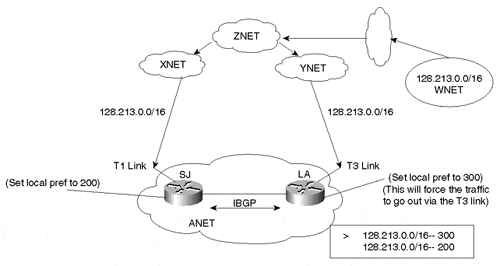
It is important for ANET to decide what path its outbound traffic will take. Of course, ANET prefers to use the T3 link via YNET in normal operation because it is a high-speed link.
This is where local preference comes into play: The LA router assigns a local preference of 300 to the routes received from YNET. The SJ router designates a lower value of, say, 200 to the routes received from XNET. Because both the LA and SJ routers exchange routing updates via IBGP, they both agree that the exit point of the AS will be via YNET because of the higher local preference. In Figure 6-14, ANET learns route 128.213.0.0/16 via XNET and YNET. The SJ and LA routers agree on using YNET as the exit point for destination 128.213.0.0/16 because of the higher local preference value of 300. Because local preference is local only to the AS (ANET), manipulations discussed in this case affect outbound traffic of the AS and not inbound traffic to the AS. Inbound traffic can still enter via the T1 link.
Cisco's proprietary weight parameter is similar to the local preference in that it gives higher preference to the route that has a higher weight. The difference is that the weight parameter is local to the router and is not exchanged between routers, even internal to an AS. The weight parameter influences routes received from different providers by the same router (for example, one router with multiple connections to two or more providers). The weight parameter has a higher precedence than any other BGP attribute; it is used as a proprietary switch to determine route preference.
The ATOMIC_AGGREGATE Attribute
Route aggregation causes a loss of information because the aggregate is coming from different sources that have different attributes. The ATOMIC_AGGREGATE attribute is a well-known discretionary attribute (Type Code 6) that gets set as an indication of information loss. Basically, if a system propagates an aggregate that causes loss of information, it is required to attach the ATOMIC_AGGREGATE attribute to the route.
The ATOMIC_AGGREGATE should not be set when the aggregate carries some extra information that indicates from where the aggregated information came. An example is an aggregate with the AS_SET parameter, as discussed earlier. An aggregate that carries the set of ASs that form the aggregate is not required to attach the ATOMIC_AGGREGATE attribute.
Tip
See the section Aggregate Only, Suppressing the More-Specific in Chapter 11.
The AGGREGATOR Attribute
The AGGREGATOR attribute is an optional transitive attribute (Type Code 7). It specifies the autonomous system and the router that has generated an aggregate. A BGP speaker that performs route aggregation might add the AGGREGATOR attribute, which contains the speaker's AS number and IP address. In Cisco's implementation, the IP address is actually the ROUTER_ID (RID), which is the loopback address of the router if one exists. If there is no loopback address, the highest IP address on the router becomes the RID. The loopback interface is the virtual interface discussed earlier in this chapter. Figure 6-15 illustrates the AGGREGATOR attribute.
Figure 6-15. AGGREGATOR Implementation Example
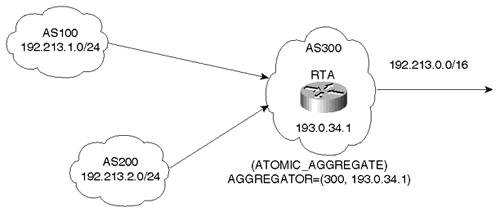
AS300 receives routes 192.213.1.0/24 and 192.213.2.0/24 from AS100 and AS200, respectively. When RTA generates aggregate 192.213.0.0/16, it has the option of including the AGGREGATOR attribute, which consists of the AS number 300 and the RID 193.0.34.1 of the router (RTA) that originated the aggregate.
The COMMUNITY Attribute
In the context of BGP, a community is a group of destinations that share some common property. A community is not restricted to one network or one autonomous system; it has no physical boundaries. An example is a group of networks that belong to the educational or government communities. These networks can belong to any autonomous system. Communities are used to simplify routing policies by identifying routes based on a logical property rather than an IP prefix or an AS number. A BGP speaker can use this attribute in conjunction with other attributes to control which routes to accept, prefer, and pass on to other BGP neighbors.
Tip
See the section The COMMUNITY Attribute in Chapter 11.
The COMMUNITY attribute (Type Code 8) is an optional transitive attribute. It is of variable length and consists of a set of 4-byte values. Communities in the range 0x00000000 through 0x0000FFFF and 0xFFFF0000 through 0xFFFFFFFF are reserved. These communities are well-known—that is, they have a global meaning. Here are some examples of well-known communities:
-
NO_EXPORT (0xFFFFFF01)— A route carrying this community value should not be advertised to peers outside an AS.
-
NO_ADVERTISE (0xFFFFFF02)— A route carrying this community value, when received, should not be advertised to any BGP peer.
Besides well-known community attributes, private community attributes can be defined for special uses. So can those defined in RFC 1998[1], which describes a mechanism by which communities can be used to manipulate BGP path selection in service provider networks.
A common practice is to use the first 2 bytes of the community attribute for the AS number and the last 2 bytes to define a value in relation to that AS. For example, a provider (AS256) who wants to define a private community called my-peer-routers could use the community 256:1 represented in decimal notation. The 256 indicates that this particular provider has defined the community. The 1 has special meaning to the provider. In this case, it is my-peer-routers.
A route can have more than one community attribute. A BGP speaker that sees multiple community attributes in a route can act based on one, some, or all of the attributes. A router has the option of adding or modifying community attributes before passing routes on to other internal and external peers.
Figure 6-16 shows a simple use of the COMMUNITY attribute. XNET is sending toward YNET routes X and Y with a NO_EXPORT community attribute, and route Z with no modification. The BGP router in YNET will propagate only route Z toward ZNET. Routes X and Y will not be propagated because of the NO_EXPORT community attribute.
Figure 6-16. Simple Application of the COMMUNITY Attribute
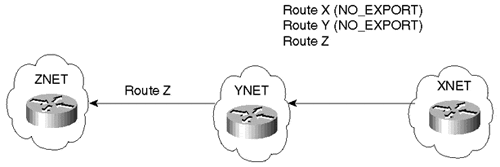
As you'll see in later chapters, communities provide a great deal of flexibility when defining routing policies.
Other Attributes
Note
The ORIGINATOR_ID, CLUSTER_ID, and CLUSTER_LIST attributes are discussed in Chapter 9, "Controlling Large-Scale Autonomous Systems."
NEXT_HOP Behavior on Multiaccess Media
A medium is considered multiaccess (MA) if routers connected to that medium can exchange data in a many-to-many relationship. Routers on an MA medium share the same IP subnet and can physically access all other routers on the medium in one hop (directly connected). Ethernet, FDDI, Token Ring, Frame Relay, and ATM are examples of multiaccess media.
The rule that IP has on MA media is that a router should always advertise the actual originator of the route in case the route's source is on the same MA medium as the router that has just learned the route. In other words, if RTA (router A) is advertising a route learned from RTB and if RTA and RTB share a common MA medium, when RTA advertises the route, it should specify RTB as the source of the route. If not, other routers, such as RTC, on the same medium would have to make an unnecessary hop via RTA to get to a router, RTB, that is sitting in the same segment.
In Figure 6-17, RTA, RTB, and RTC share a common multiaccess medium. RTA and RTC are running EBGP, and RTC and RTB are running OSPF. RTC has learned network 11.11.11.0/24 from RTB via OSPF. RTC is advertising that prefix to RTA via EBGP. Because RTA and RTB are running different routing protocols, you might think that RTA would consider RTC (10.10.10.2) as its next hop to reach 11.11.11.0/24, but this is incorrect. The correct behavior is for RTA to consider RTB (10.10.10.3) as the next hop because RTB shares the same medium with RTC.
Figure 6-17. Sample Multiaccess Media Environment
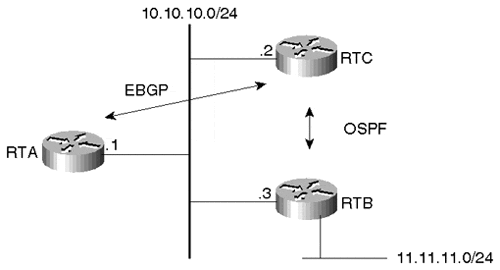
In situations where the medium is broadcast, such as Ethernet and FDDI, physical connectivity is a given, and the next-hop behavior is no problem. In situations where the medium is nonbroadcast, such as Frame Relay and ATM, special care should be taken, as described in the following section.
NEXT_HOP Behavior Over Nonbroadcast Multiaccess Media
Media such as Frame Relay and ATM are referred to as nonbroadcast multiaccess media. The many-to-many direct interaction between routers is not guaranteed unless virtual circuits are configured from each router to all other routers. This is referred to as a full-mesh topology, and it is not always implemented for a number of reasons. In practice, Frame Relay or ATM virtual circuits are provided by the access carrier at a certain dollar amount per circuit, and additional circuits translate into extra money. In addition to this prohibitive cost, many organizations use a hub and spoke approach, in which multiple remote sites have virtual circuits built to one or more concentration routers at a central site (the hub site) where information resides. Figure 6-18 illustrates an example of next-hop behavior in a nonbroadcast multiaccess environment.
Figure 6-18. Nonbroadcast Multiaccess NEXT_HOP Example

The only difference between the environments illustrated in Figure 6-17 and Figure 6-18 is that the medium in Figure 6-18 is a Frame Relay cloud that is NBMA. RTC is the hub router, and RTA and RTB are the spokes. Notice how the virtual circuits are laid out between RTC and RTA, and between RTC and RTB, but not between RTA and RTB. This is called a partial-mesh topology.
RTA gets a BGP routing update about 11.11.11.0/24 from RTC, which in turn learns about the prefix from the originator RTB. RTA will try to use RTB (10.10.10.3) as the next hop (the same behavior as on MA media). Packet forwarding will fail because no virtual circuit exists between RTA and RTB.
Cisco IOS software supports a special-case parameter that remedies this situation. The next-hop-self parameter (configured as part of the BGP neighbor command) forces the router (in this case, RTC) to advertise 11.11.11.0/24 with itself as the next hop (10.10.10.2). RTA would then direct its traffic to RTC to reach destination 11.11.11.0/24.
Use of next-hop-self versus Advertising DMZ
The demilitarized zone (DMZ) defines a shared network between ASs. The IP subnet used for the DMZ link might or might not be owned by any of the networked ASs. As you have already seen, the next-hop address learned from the EBGP peer is preserved within IBGP. It is important for the IGP to be able to reach the IP address denoted via the NEXT_HOP attribute in the UPDATE message. One way to do this is for the DMZ subnet to be part of the IGP and have the subnet advertised in the AS. The other method is to override the next-hop address by forcing the next hop to be the IP address of the border IBGP neighbor.
In Figure 6-19, the SJ router is receiving updates about 128.213.1.0/24 with next hop 1.1.1.1 (part of the DMZ). For the SJ router to be able to reach this next hop, one option is for network 1.1.1.0/24 to be advertised inside the AS by the SF border router.
Figure 6-19. Using the next-hop-self Parameter

The other option is to have the SF router set the next-hop-self parameter as part of the IBGP neighbor connection to the SJ router. This will set the next-hop address of all EBGP routes to 2.2.2.2, which is already part of the IGP. The SJ router can now reach the next hop with no problem.
Choosing one method over another depends on whether you want to reach the DMZ. An example could be an operator trying to do a ping from inside the AS to a router interface that belongs to the DMZ. For the ping to succeed, the DMZ must be injected into the IGP. In other cases, the DMZ might be reachable via some suboptimal path external to the AS. Instead of reaching the DMZ from inside the AS, the router might attempt to use another EBGP link to reach the DMZ. In this case, using next-hop-self ensures that the next hop can be reached from within the AS. In all other cases, both methods are similar as far as the BGP routing functionality.
Also, it is important to understand that Internet exchange point participants often require that the BGP NEXT_HOP specified in UPDATE messages be that of the peer's IP address, as a matter of policy.
Using Private ASs
To conserve AS numbers, the InterNIC generally does not assign a legal AS number to customers whose routing policies are an extension of the policies of their provider. Thus, when a customer is single-homed or multihomed to the same provider, the provider generally requests that the customer use an AS number taken from the private pool of ASs (64512 to 65535). As such, all BGP updates that the provider receives from its customer contain private AS numbers.
Tip
See the section Using Private ASs in Chapter 11.
Private AS numbers cannot be leaked to the Internet because they are not unique. For this reason, Cisco has implemented a feature to strip private AS numbers out of the AS_PATH list before the routes are propagated to the Internet, thereby performing a type of proxy advertisement function. Figure 6-20 demonstrates how private AS numbers are stripped from the AS_PATH list.
Figure 6-20. Stripping Private AS Numbers

Note
Chapter 1, "Evolution of the Internet," introduced Network Access Points (NAPs) and their role in interconnecting multiple providers. BGP connections to the NAP are sometimes done via a route server where multiple ASs peer via EBGP into a single system. The route server would have its own AS number. In Figure 6-20, the NAP is represented by the route server RTE having AS number 7. The route server concept could apply any time multiple ASs rely on a single point for exchanging EBGP updates.
In Figure 6-20, AS1 is providing Internet connectivity to its customer AS65001. Because the customer has only this provider and has no plans to add another provider in the near future, the customer has been allocated a private AS number by the provider. If the customer later needs to connect to another provider, the appropriate Internet Registry should assign a globally unique AS number.
Prefixes originating from AS65001 have an AS_PATH of 65001. Note prefix 172.16.220.0/24 in Figure 6-20 as it leaves AS65001. For AS1 to propagate the prefix to the Internet, it has to strip the private AS number. When the prefix reaches the Internet, it will look as though it originated from the provider's AS. Note how prefix 172.16.220.0/24 has reached the NAP with AS_PATH 1.
BGP will strip private ASs only when propagating updates to the external peers. This means that the AS stripping would be configured on RTC as part of its neighbor connection to RTE.
Private ASs should be connected to only a single provider. If the AS_PATH contains a mixture of private and legal AS numbers, BGP will view this as an illegal design and will not strip the private AS numbers from the list, and the update will be treated as usual. Only AS_PATH lists that contain at least one private AS number in the range of 64512 to 65535 are stripped.
For additional information describing a routing architecture using private ASs, see RFC 2270[2], "Using a Dedicated AS for Sites Homed to a Single Provider."
AS_PATH and Route Aggregation Issues
Route aggregation involves summarizing a range of prefixes into one or more aggregates or CIDR blocks to minimize the number of routes in the routing tables. A drawback of route aggregation is the loss of granularity that exists in the specific routes that form the aggregate. For example, the AS_PATH information that exists in multiple routes will be lost when these routes are summarized into a single advertisement. This could lead to routing loops, because a route that has passed through an AS might be accepted by the same AS as a new route.
In order to avoid this unwanted behavior, BGP defines another type of AS_PATH object called an AS_SET, where the ASs are listed in an unordered set. This set includes the ASs that a route has traversed. Aggregates carrying the AS_SET information would have a collective set of the attributes that form the individual routes they summarize.
In Figure 6-21, AS1 is advertising 192.213.1.0/24, and AS2 is advertising 192.213.2.0/24. AS3 is aggregating both routes into 192.213.0.0/16. An AS that advertises an aggregate considers itself the originator of that route, irrespective of where that route came from. When AS3 advertises the aggregate 192.213.0.0/16, the AS_PATH information would be just 3. This would cause a loss of information because the originators of the routes AS1 and AS2 would no longer be listed in the AS_PATH. In the situation where some other AS somehow advertises the aggregate back to AS1 and AS2, AS1 and AS2 would accept the route. This could lead to routing loops.
Figure 6-21. Effects of the AS_SET

With the notion of AS_SET, it is possible to have AS3 advertise the aggregate 192.213.0.0/16 while keeping information about the components of the aggregate. The set {1 2} indicates that the aggregate has come from both of these ASs in no particular order. The AS_PATH information of the aggregate with the AS_SET option would be 3 {1 2}.
Specifying the AS_SET parameter before an aggregate-address statement will automatically generate an AS_SET associated with the aggregate.
AS_PATH Manipulation
AS_PATH information is often manipulated to affect interdomain routing behavior. Because BGP prefers a shorter AS_PATH path to a longer one, network operators are tempted to change the path information by including dummy AS_PATH entries that would increase the path length to influence or deter the traffic trajectory. Cisco's implementation lets a user prepend AS numbers at the beginning of an AS_PATH to make the path length longer. The following example shows how this feature can be used.
Tip
See the section AS_PATH Manipulation in Chapter 11.
In Figure 6-22, AS50 is connected to two providers, AS200 and AS100. AS100 is directly connected to the NAP, whereas AS200 has to go through an extra hop via AS300 to reach the NAP.
Figure 6-22. Routing Environment Before Dummy AS Is Prepended
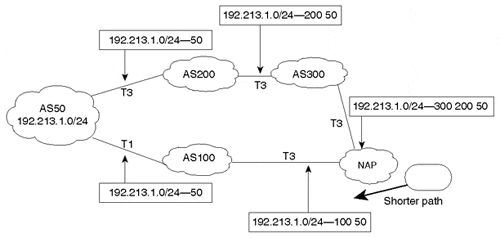
Figure 6-22 shows instances of prefix 192.213.1.0/24 as it traverses the ASs on its way to the NAP. When the 192.213.1.0/24 prefix reaches the NAP via AS300, it has an AS_PATH of 300 200 50. If the same prefix reached the NAP via AS100, it would have an AS_PATH of 100 50, which is shorter than the path via AS300. ASs upstream from the NAP will prefer the shorter AS_PATH length and will direct their traffic toward AS100 for destination 192.213.1.0/24.
AS50 is unhappy about this behavior, because it prefers the traffic to be directed inbound via its higher-bandwidth T3 link to AS200. AS50 will manipulate the AS_PATH information by inserting dummy AS numbers when sending routing updates to AS100. One common practice is for AS50 to repeat its AS number as many times as necessary to tip the balance and make the path via AS200 shorter.
In Figure 6-23, AS50 inserts the two AS numbers 50 50 only at the front of the AS_PATH of prefix 192.213.1.0/24, which is advertised to AS100. When the prefix 192.213.1.0/24 reaches the NAP via AS100, it will have the AS_PATH 100 50 50 50, which is longer than the AS_PATH 300 200 50 via AS300. ASs upstream of the NAP will prefer the shortest path and will direct the traffic toward AS300 for destination 192.213.1.0/24.
Figure 6-23. Routing Environment After Dummy AS Is Prepended
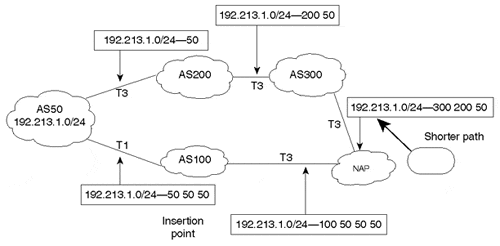
In practice, the bogus number should always be a duplicate of the AS announcing the route or the neighbor the route is learned from (in case an AS is increasing the path length for incoming updates). Adding any other number is misleading and could potentially lead to routing loops or black holes. Note the insertion point in Figure 6-23.
